On February 2nd, the Kansas City Royals secured their future by extending their home-grown, superstar shortstop Bobby Witt Jr. to an 11-year/$288m deal. The contract is loaded with both opt-outs and incentives that give Witt tremendous flexibility, as the Royals go all in on the future of their franchise. Initially outshined by Julio Rodríguez and Adley Rutchmann in the 2022 prospects class, it seems like Witt, who had a 30 home run and 49 stolen base sophomore season, is blossoming to become the player the Royals expected when he was named the number one prospect in baseball.
This article isn’t about him.
No, instead this article is about the guy who plays just to the left of Witt. Maikel Garcia didn’t earn a Rookie of the Year vote, he wasn’t on the All-Star ballot, and in part because he played for a Royals team that put together just 56 wins, received very little attention for his performance. Yet Garcia, who will turn 24 this March, put together a 2023 campaign that should inspire confidence in any Royals fan, and who could be a key asset to a Royals team looking to climb themselves out of the league’s cellar.
Royal Defense
So, before we get into Garcia’s glove, let’s talk about Kansas City. If you’re reading this website, you’re probably familiar with Statcast Outs Above Average (OAA), Defensive Runs Saved (DRS), and Ultimate Zone Rating (UZR). These three advanced defensive metrics are the most popular sabermetric stats to evaluate defense, but they tend to disagree with each other. While researching for this piece, I found this excellent article by Alex Eisert explaining a peculiarity regarding Kansas City’s infield, illustrated by this (not so) lovely graph:
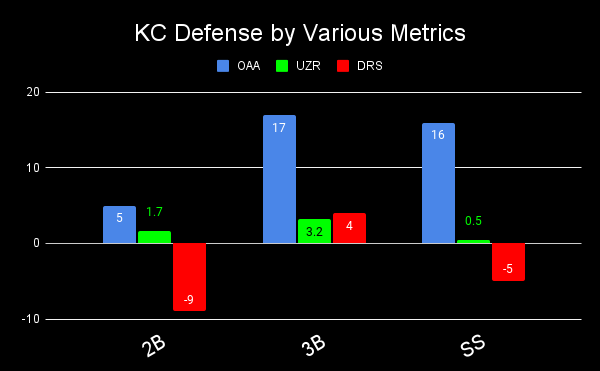
It’s worth keeping in mind that single-season sample sizes can create oddities in defensive metrics, but in this case, I think it’s clear that there’s a fundamental disagreement between how these metrics view Kansas City’s defense. When Witt wasn’t selected as a Gold Glove finalist this past season, many pointed to his OAA mark as an example of voter ineptitude, yet Witt’s -6 DRS would be a valid reason to leave his name off the ballot. It is important to note that defensive metrics are not perfect, despite the leaps and bounds they have taken in the past 20 years.
That being said, Garcia, who was a shortstop in the minors before being moved to third to accommodate Witt, is certainly a good defender. His pedigree as a prospect was largely based on his defensive capabilities, and he’s made some sensational plays in his rookie year. Take this clip against the A’s for instance:
— Carson Picard (@PLCars0n) February 15, 2024
This ball was hit 97.6 mph off the bat and down the line, yet Garcia was able to snag it and make the throw for a spectacular out. Making this play more incredible is he nabbed Zack Gelof, whose 4.37 second home-to-first time is considerably above league average. Look, you don’t have to believe that Maikel Garcia was an elite third baseman like his OAA would indicate, but it’s safe to say he is at least good.
But what if we did believe in Statcast Outs Above Average? That graph earlier is a little misleading, because it includes all players at third for Kansas City, but Garcia still played the majority of Kansas City’s innings at the hot corner. Garcia finished with 13 OAA at third base this season, despite only playing 103 games at the position. Is that good?
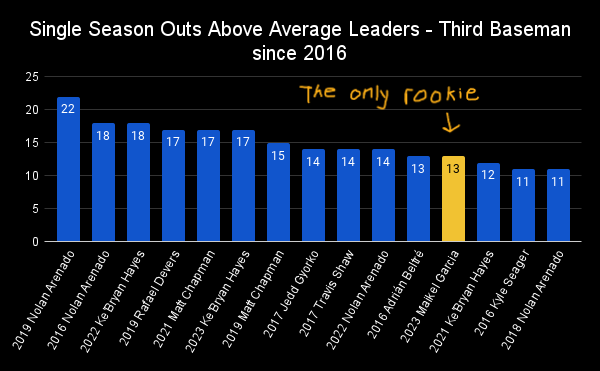
2019 Rafael Devers aside, this is a heck of a list to be a part of. Now, I can’t stress this enough – TAKE THIS WITH A GRAIN OF SALT!!! Single-season defensive metrics can yield some wild results, and an ~850 inning sample size is not enough to make a definitive evaluation of his defensive ability. With all that being said go scroll up and watch that clip against the A’s again.
Sexy, right?
Statcast believes there hasn’t been a rookie third baseman in the last eight years that has been as effective defensively as Garcia, and that’s high praise no matter how you slice it.
One last bit here – in that clip robbing Gelof, Garcia showcased his arm strength, which is one of the stronger arms among third basemen. Garcia ranks seventh in arm strength among third basemen with at least 100 recorded throws, and only Matt Chapman throws harder from the hot corner with as many attempts as Garcia has. Now, the correlation between arm strength and defensive effectiveness at third is, well, basically nothing, but it speaks to the tools that Garcia possesses. He’s no Elly De La Cruz, but Garcia’s arm, mixed with his well above speed at third (28.2 feet per second, 15th out of 67 among third basemen) gives him the tools for long-term success.
That’s Great, Can He Hit?
Uh.
Well.
Look, you probably haven’t heard about Maikel Garcia, or at least, maybe not that much unless you’re a die-hard Royals fan, and the reason behind that is because he had an 84 WRC+ last year and a slugging of just .358.
Wait the title said “star”
I KNOW WHAT THE TITLE SAYS!
Ok, give me a chance here. Take a look at this:
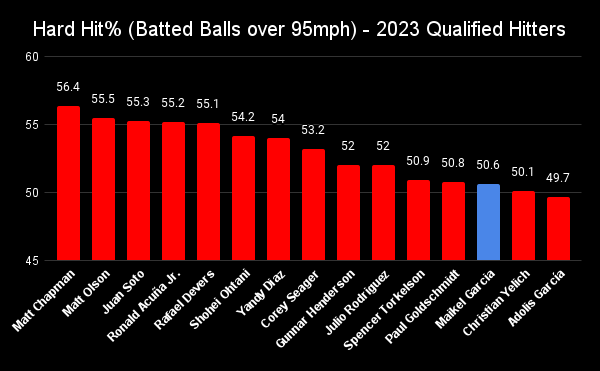
This is, quite frankly, astonishing. Just look at the names here. These are some of the best sluggers in baseball, and yet here’s Maikel Garcia, with an ISO of .086. It frankly seems impossible, and the absurdities only continue when you look at straight barrel rates and home runs:
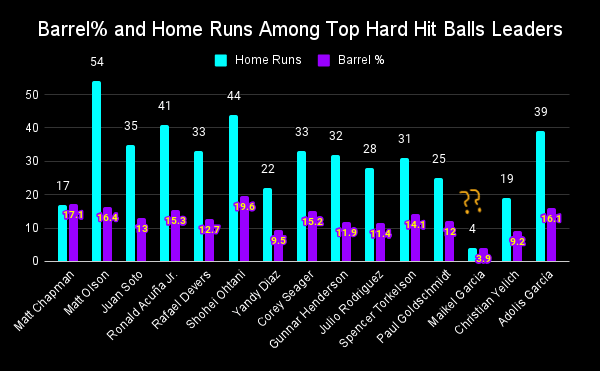 That doesn’t seem right! Garcia smashes the ball, yet it doesn’t result in barrels or home runs. Only two qualified hitters had fewer home runs than Garcia in 2023: Tim Anderson and Myles Straw, who both notched just one long ball apiece. There is nobody else in baseball who has this hitter profile.
That doesn’t seem right! Garcia smashes the ball, yet it doesn’t result in barrels or home runs. Only two qualified hitters had fewer home runs than Garcia in 2023: Tim Anderson and Myles Straw, who both notched just one long ball apiece. There is nobody else in baseball who has this hitter profile.
So, why is Maikel Garcia, who smashes the ball as well as anyone, not among the better home run hitters in the league? It’s tempting to simply say launch angle, but that’s not exactly right. Garcia’s average launch angle of 6.1 is certainly low, but that alone isn’t indicative of slugging. Take, for instance, this table of hitters with a similar average launch angle to Garcia:
So, clearly, it’s not just a matter of launch angle. There’s something else afoot here. We’ve seen a few visuals on Garcia’s hitter profile, but how about we watch the dude hit? Here are the five hardest-hit balls of 2023 for Garcia:
110 mph, 13 deg LA pic.twitter.com/vhILHtFMP8
— Carson Picard (@PLCars0n) February 15, 2024
108.4 mph, -3 LA pic.twitter.com/p7u2OmXsju
— Carson Picard (@PLCars0n) February 15, 2024
108.1 mph, 6 LA pic.twitter.com/JwhUXsQHDI
— Carson Picard (@PLCars0n) February 15, 2024
108 mph, 8 LA pic.twitter.com/xvAfzShcxi
— Carson Picard (@PLCars0n) February 15, 2024
107.8 mph, 10 LA pic.twitter.com/yMguBBnHcm
— Carson Picard (@PLCars0n) February 15, 2024
Of Garcia’s five hardest-hit balls, three are ground balls and the other two are sharp line drives. This isn’t necessarily atypical batted ball distribution for balls with this exit velo, but Garcia’s flat swing creates far more line drives and grounders than it does dangerous fly balls. We already touched on Garcia’s launch angle, but I want to narrow in on the difference between Garcia and a player with a similar hitter profile, Bo Bichette:
The batted ball distribution for Garcia and Bichette are extremely similar, as is the average launch angle, and they also have similar hard-hit rates. Yet, Bichette has nearly twice the ISO and five times the home runs. Perhaps the thing that stands out most is the home run per fly ball rate. Bichette’s 20.2% is in the 81st percentile of hitters, and Garcia is right toward the bottom, being in the 7th percentile. There’s no one reason for this discrepancy, and some of it is simply due to luck – Garcia has to contend against Kaufmann Stadium’s enormous outfield – but take a look at this Bo Bichette home run from September:
106.9 mph, 33 deg LA pic.twitter.com/XPUCNfdjjv
— Carson Picard (@PLCars0n) February 19, 2024
Maikel Garcia does not have this swing. This sort of swing, designed to elevate, is something that’s notably lacking in Garcia’s arsenal. I don’t need Garcia to adopt a Kyle Schwarber-like approach, but having a power swing focused on elevating the ball would lead to greatly increased slugging and, of course, an increase in offensive output. Garcia may not have top-end power, but he’s not Myles Straw. There are plenty of players who are able to put up respectable home run and SLG numbers that have neither the bat-to-ball skills nor the power of Garcia. Willy Adames puts up 20-30 home runs a year, Mookie Betts just hit 39 – neither of these players hit the ball any harder than Garcia does, but they have the swing to elevate if they need to. As I said earlier, this isn’t just a matter of launch angle, Garcia simply doesn’t possess a true home run swing.
That can be fixed, but it’s not going to be easy to do, changing a player’s mechanics can be a difficult endeavor. However, if Garcia can increase his home run to fly ball rate to even double digits, Garcia can easily be an above-average hitter. With his defense at third, he’s an incredibly valuable player. If Garcia can go even further, cutting down on his strikeouts and increasing his barrel rate, then he could be a serious offensive force next to Witt.
The good news for Garcia is he has a solid foundation to build upon. Not only does Garcia hit the ball hard, but his whiff rate of 19.5% is well below league average, displaying his above-average contact ability. Despite Garcia’s extremely low barrel rate, his Ideal Contact Rate of 44.2% was 23rd among qualified hitters, meaning that despite the low WRC+, Garcia has a lot of positive attributes in the batter’s box.
Eyes
Maikel Garcia smashes the ball, yet doesn’t slug. That’s an interesting story in and of itself, but there’s another element to Garcia’s game that makes him an especially intriguing player: his plate discipline.
Garcia is an especially selective hitter. That isn’t necessarily a good thing, but it does project well for future success in MLB. Patience at the plate is a skill that can be very rewarding for the hitter, avoiding swinging at suboptimal pitches and working the count to your favor. We’ll talk about Garcia’s approach more in a bit, but first here’s another graph with a bunch of hitters, this time looking at the top 15 hitters by O-Swing%, and their corresponding walk rate:
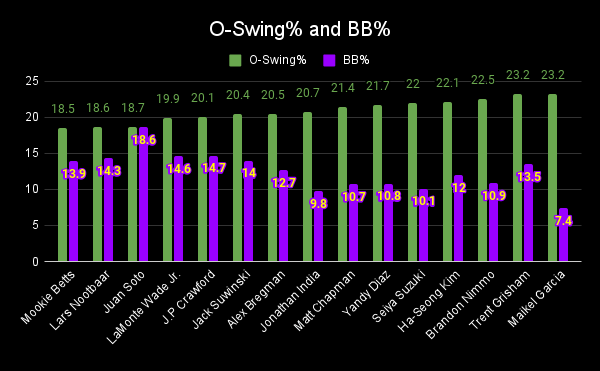
There he is again, top 15 in a hitter’s stat next to a bunch of top hitters in the game (and Trent Grisham). It’s not as strong of a correlation as hard-hit rate, but these are some excellent hitters, and being on any list with Mookie Betts and Juan Soto is good company. Garcia’s chase rate raises his floor significantly, and it’s reasonable to suggest that his 7.4 walk rate will increase over time. Again, we’ll talk about his approach in a bit, but I want to first elaborate on his plate discipline on pitches outside the strike zone by looking at the four pitch zones: Heart/Shadow/Chase/Waste:

We’ve talked at length about Garcia’s struggles with the bat, and how his lack of slugging hurts his overall output. Just for a bit though, let’s set aside his performance in the heart of the plate to talk about the other three zones. Garcia’s chase rate is significantly better than the league average, and it gives him +21 runs between his Chase and Waste zones. That -7 shadow runs may sound bad, but pitches in the shadow of the plate almost always result in a negative outcome for the hitter, so despite it generating -7 runs, that ranks him 68th/300, in the same ZIP code as Mike Trout and Kyle Tucker.
Looking just at Shadow/Chase/Waste, Garcia had a run value of +14 between those three zones. That’s very good! Especially good considering Garcia is attacked in the zone significantly more than most hitters, evidenced by his 95th percentile zone rate of 48.7%. Shadow+Chase+Waste run value can tell us quite a bit about a player’s plate discipline, so here’s a fun comparison:

It might seem like Aaron Judge and Maikel Garcia have just about nothing in common – and you’d be right in terms of what happens when they swing the bat at pitches in the heart of the zone – But let’s just look at their Shadow/Chase/Waste zones. Between the Shadow/Chase/Waste zones, Garcia and Judge swing at all three at almost the exact same rates. Furthermore, the difference between Judge and Garcia in terms of pitches seen is only 87, so this is a fair comparison between two right-handed hitters. Let’s put this into a nice-looking table:
Judge gets hurt more on Shadow swings than Garcia, likely a result of his power-centric approach, but he also saw nearly 100 more pitches in the Chase zone than Garcia, no doubt because pitching to Aaron Judge is a scary endeavor. Just looking at Swing/Take results though, Garcia and Judge have nearly identical ratios, and Judge only marginally beats out Garcia in Shadow/Chase/Waste run value. What makes Aaron Judge such a fantastic hitter is that he not only has prodigious power but the plate discipline to avoid chasing bad pitches. Pitching against Aaron Judge? You are going to need to beat him in the zone, and you better not leave one over the middle. Garcia obviously does not have Judge’s prodigious power and pitchers aren’t really scared of him, but like Judge, if you are going to beat Garcia in an at-bat you’re going to need to beat him in the strike zone.
However, while Garcia does an excellent job at laying off pitches outside the zone, his walk rate remains below league average, which is indicative of a problem Garcia has, which is getting behind in the count. His 64.2% first-pitch strike rate is one of the highest in MLB, which is partially a result of his low slugging – if you’re not a power threat, pitchers aren’t as scared to attack the zone – but Garcia’s passiveness in his plate approach can work against him in the count. His called strike rate of 20.4% is extremely high, as is his early called strike rate of 26.1%. Those are free strikes! Garcia does a great job at not giving pitchers strikes outside of the zone, but his lack of aggression can sometimes give him fewer advantageous counts.
Coming into the 2024 season, it would serve Garcia well if he was more aggressive in the strike zone. His 72% swing rate in the heart of the plate means he’s leaving 28% of pitches as free strikes. If he’s more aggressive in the heart of the zone, and potentially with a higher barrel rate, that ugly -19 Heart runs could be whittled down significantly to single-digit negatives or even a net positive, which would be a TREMENDOUS improvement overall. Jumping on those perfect pitches to hit could yield great results for Garcia, and the overall benefit could totally change his offensive production.
Future King of Kauffman?
Maikel Garcia is an enigma. He hits the ball hard but doesn’t slug. He doesn’t chase but doesn’t put up great walk numbers. However, these are all fixable flaws, and just a few minor adjustments are likely needed to take Garcia from a below-average hitter to an above-average one. Of course, Garcia is still very young, so it’s reasonable to believe that he’s not a finished product yet. The tools are there, and his glove is so strong that he’s already a starting-caliber third baseman despite the weak rookie offensive output.
There’s a possibility the necessary adjustments aren’t made and Garcia struggles to have any real game power, but there’s also a possibility he hits 20 home runs a year and uses his already excellent chase rate to bring his BB% rate well into the double digits. After dominating the Venezuelan Winter League, hitting .424 in 29 games, Garcia is arriving at spring training looking to be the Royals’ starting third baseman. For a player who was signed for practically nothing as an international free agent and received little attention as a prospect, he has a chance to make a huge impact for a Royals team looking to re-establish themselves in the AL Central. While all the attention is likely going to be centered around Witt and Cole Ragans this spring, expect Garcia to play a large role this season.
Oh, and one last thing. Any good royal should come from a rich bloodline, and Maikel Garcia is no different. His cousin?

Wow, what an excellent article, and the author is so handsome too!